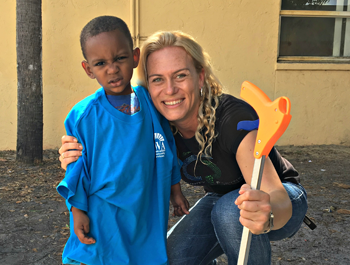Image

Kimberly Brumber, President and CEO, NeighborWorks Community Partners
Challenge: Community development organizations (CDCs) struggle for survival as traditional support from public agencies and private foundations shrinks and the need for their assistance expands. If CDCs are forced to close their doors it would open a significant gap through which communities could slip with little hope of recovery.
The Rust Belt communities in western New York suffer from high poverty rates, abandoned buildings and aging, deteriorating housing whose low market prices can't lure investments to rescue them. More than one-quarter of the populations of Rochester, Niagara Falls and Buffalo live below the federal poverty level. Meanwhile, the usual safety nets are increasingly fragile. Funding cuts for community development corporations over the past decade have severely curbed their ability to provide vital services like homebuyer education and counseling, lending, residential rehab and energy efficiency assistance. The dwindling funds also hinder neighborhood revitalization programs designed to strengthen communities which have seen plummeting investments. Moreover, small CDCs face escalating costs, increased regulations and complex business lines that require skilled workers, certifications and licenses. It has become even more difficult to meet the urgent needs of underserved communities.
In response to this looming crisis, four independent CDCs in Western New York consolidated in 2015, using an innovative structure unprecedented in nonprofit mergers.
NeighborWorks Rochester, West Side Neighborhood Housing Services (NHS), Niagara Falls NHS and Black Rock-Riverside NHS joined together under a new umbrella organization: NeighborWorks Community Partners. We have two locations in Buffalo, one in Niagara Falls and one in Rochester. Our umbrella organization based in Rochester supports the local affiliates serving high-need communities across 16 counties.
This partnership uses a unique structure that allows for a strong local voice to respond to specific community needs, while it standardizes some programs across the region to increase the number of people served. Unlike most nonprofit mergers, all four local affiliates entered into this partnership as thriving, productive organizations. Regardless of size, they come together as equals; the consolidation is a voluntary and proactive response to the imperative to do more with less. Under this new system, the affiliates aim to increase the number of residents they serve by more than 60 percent within five years, for a total of 12,600 families served and $176 million invested in the region by the end of 2021.
 The consolidation is designed to provide the scale needed to support stronger back office support functions such as strategic direction, financing, human resources, technology and reporting. It also increases the ability to deliver highly technical lines of business like lending and energy services, while allowing for unique services tailored to the communities' needs. The strategy leads to increased impact in existing service areas as well as expansion into underserved areas throughout the region.
The consolidation is designed to provide the scale needed to support stronger back office support functions such as strategic direction, financing, human resources, technology and reporting. It also increases the ability to deliver highly technical lines of business like lending and energy services, while allowing for unique services tailored to the communities' needs. The strategy leads to increased impact in existing service areas as well as expansion into underserved areas throughout the region.The partnership capitalizes on the network effect, allowing the organizations to draw on each member's strengths and expertise, creating a hybrid service delivery approach. By sharing administrative and leadership functions, we increase efficiency and cooperate more cost-effectively. The regional scale positions the organizations to attract new partners and greater support leveraging, ultimately enhancing long-term sustainability.
What makes this merger different is a decentralized leadership approach combined with representative governance. The regional organization has limited hierarchy and provides standardization where it adds value. This allows us to provide a platform of uniform offerings proportionately across a larger area while providing for the more specific needs of each community. Our new structure gives us the best of both worlds: capitalizing on our size where it makes sense and leveraging our local advantage and responsiveness when that is needed.
Control of the organization comes from a regional board of twelve members, three representatives from each of the local organizations. Ultimately, this system is more complex and more challenging to develop than most nonprofit mergers, but it allows us to include each community's voice and needs in the foundation of our work.
The corporate structure was intentionally built so that organizations can be added easily, allowing them access to a sustainable business model, while exponentially increasing the network's effect and overall strength. This is not about taking what the strongest organization does and replicating it across the network. Rather, this improves on what any one of the existing organizations brings to the consolidation.
As CDCs grow, they often lose their focus as they shift from a household-level approach to community-wide revitalization efforts. Our new structure builds regional programs that can be scaled effectively while retaining a more comprehensive approach, increasing our impact at both the household and the community level. Without this approach, these high-need communities would be in peril of losing the organizations that provide critical services. Much of what these CDCs offer is unique and if they were to close, their communities would lose vital services and resources and many households would have nowhere to turn for assistance.
The list of lessons learned is long. Building an unprecedented structure such as this takes considerable effort and making the change takes much longer than expected. Although it has been a challenging process, we are confident this new structure will reap benefits for decades to come and ensure the sustained delivery of critical services to communities across the region with high levels of need.

